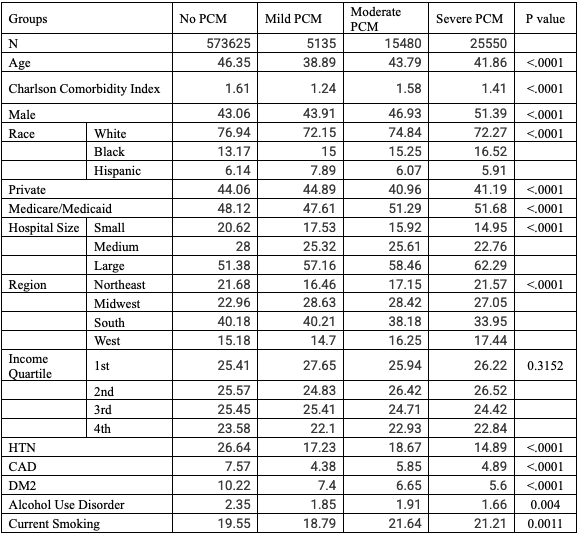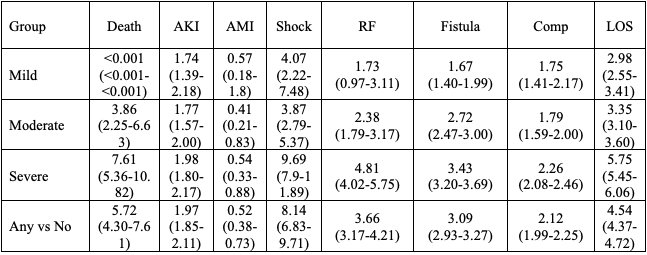Monday Poster Session
Category: IBD
P3253 - Outcomes of Hospitalized Crohn’s Patients Based on Severity of Protein-Calorie Malnutrition: A 6-Year Nationwide Study
Monday, October 27, 2025
10:30 AM - 4:00 PM PDT
Location: Exhibit Hall

Andrej M. Sodoma, DO
Northwell Health
Lake Grove, NY
Presenting Author(s)
Andrej M. Sodoma, DO1, James Pellegrini, MD2, Samuel Greenberg, BA3, Richard Pellegrini, BS4, Bi Zhang, DO5, Mary Thomas, DO5, Jaspreet Singh, MD5
1Northwell Health, Lake Grove, NY; 2Nassau University Medical Center, East Meadow, NY; 3Stony Brook Medicine, Stony Brook, NY; 4St. George's University School of Medicine, Great River, NY; 5Northwell Health, Bay Shore, NY
Introduction: Crohn's disease has been steadily becoming more prevalent in the USA. A prevalent problem in Crohn’s is protein-calorie malnutrition (PCM), with roughly 65%-75% of these patients experiencing some form of malnutrition.
Methods: The National Inpatient Sample (NIS) was used to identify patients diagnosed with Crohn’s disease using the International Classification of Diseases (ICD) 10 codes. Crohn’s disease patients were analyzed for baseline characteristics, and various primary outcomes were analyzed. Outcomes were compared between groups, and odds ratios were calculated using weighted logistic regression.
Results: 619,790 patients admitted for Crohn’s were included in this study. Patients with no PCM were more complex and older, with a CCI of 1.61 and 46.35 years (p < 0.0001), while the other groups were younger and less complex. Patients with hypertension (HTN), coronary artery disease (CAD), diabetes type two (DM2), and alcohol use disorder were found to have a higher percentage in non-PCM patients at 26.64%, 7.57%, 10.22%, and 2.35%, respectively (p < 0.05). Moderate PCM patients were found to have a higher percentage of current smokers at 21.64% (p< 0.011). PCM patients were compared to non-PCM patients, and PCM patients were found to have higher odds of death (OR (95% CI): < 0.001 (< 0.001-< 0.001) mild, 3.86 (2.25-6.63) moderate, 7.61 (5.36-10.82) severe). AKI (1.74 (1.39-2.18) mild, 1.77 (1.57-2.00) moderate, 1.98 (1.80-2.17) severe). Shock (4.07 (2.22-7.48) mild, 3.87 (2.79-5.37) moderate, 9.69 (7.9-11.89) severe), respiratory failure (1.73 (0.97-3.11) mild, 2.38 (1.79-3.17) moderate, 4.81 (4.02-5.75) severe), fistula development (1.67 (1.40-1.99) mild, 2.72 (2.47-3.00) moderate, 3.43 (3.20-3.69) severe), and composite outcomes (1.75 (1.41-2.17) mild, 1.79 (1.41-2.17) moderate, 2.26 (2.08-2.46) severe), which increased with the increasing severity of PCM. In turn, they had higher LOS (2.98 (2.55-3.41) mild, 3.35 (3.10-3.60) moderate, 5.75 (5.45-6.06) severe) and hospital charges (33562 (21826-45298) mild, 27120 (24110-30130) moderate, 50471 (46,695-54,247) severe).
Discussion: Crohn’s patients are at an increased risk of adverse outcomes based on the severity of PCM; more research should be done on how to better treat severe PCM in Crohn’s disease.

Figure: Table 1: Baseline Characteristics of Patients Admitted for Crohn's Flare Stratified by PCM

Figure: Table 2: Outcomes for Patients Admitted for Crohn's, divided by the severity of PCM
Disclosures:
Andrej Sodoma indicated no relevant financial relationships.
James Pellegrini indicated no relevant financial relationships.
Samuel Greenberg indicated no relevant financial relationships.
Richard Pellegrini indicated no relevant financial relationships.
Bi Zhang indicated no relevant financial relationships.
Mary Thomas indicated no relevant financial relationships.
Jaspreet Singh indicated no relevant financial relationships.
Andrej M. Sodoma, DO1, James Pellegrini, MD2, Samuel Greenberg, BA3, Richard Pellegrini, BS4, Bi Zhang, DO5, Mary Thomas, DO5, Jaspreet Singh, MD5. P3253 - Outcomes of Hospitalized Crohn’s Patients Based on Severity of Protein-Calorie Malnutrition: A 6-Year Nationwide Study, ACG 2025 Annual Scientific Meeting Abstracts. Phoenix, AZ: American College of Gastroenterology.
1Northwell Health, Lake Grove, NY; 2Nassau University Medical Center, East Meadow, NY; 3Stony Brook Medicine, Stony Brook, NY; 4St. George's University School of Medicine, Great River, NY; 5Northwell Health, Bay Shore, NY
Introduction: Crohn's disease has been steadily becoming more prevalent in the USA. A prevalent problem in Crohn’s is protein-calorie malnutrition (PCM), with roughly 65%-75% of these patients experiencing some form of malnutrition.
Methods: The National Inpatient Sample (NIS) was used to identify patients diagnosed with Crohn’s disease using the International Classification of Diseases (ICD) 10 codes. Crohn’s disease patients were analyzed for baseline characteristics, and various primary outcomes were analyzed. Outcomes were compared between groups, and odds ratios were calculated using weighted logistic regression.
Results: 619,790 patients admitted for Crohn’s were included in this study. Patients with no PCM were more complex and older, with a CCI of 1.61 and 46.35 years (p < 0.0001), while the other groups were younger and less complex. Patients with hypertension (HTN), coronary artery disease (CAD), diabetes type two (DM2), and alcohol use disorder were found to have a higher percentage in non-PCM patients at 26.64%, 7.57%, 10.22%, and 2.35%, respectively (p < 0.05). Moderate PCM patients were found to have a higher percentage of current smokers at 21.64% (p< 0.011). PCM patients were compared to non-PCM patients, and PCM patients were found to have higher odds of death (OR (95% CI): < 0.001 (< 0.001-< 0.001) mild, 3.86 (2.25-6.63) moderate, 7.61 (5.36-10.82) severe). AKI (1.74 (1.39-2.18) mild, 1.77 (1.57-2.00) moderate, 1.98 (1.80-2.17) severe). Shock (4.07 (2.22-7.48) mild, 3.87 (2.79-5.37) moderate, 9.69 (7.9-11.89) severe), respiratory failure (1.73 (0.97-3.11) mild, 2.38 (1.79-3.17) moderate, 4.81 (4.02-5.75) severe), fistula development (1.67 (1.40-1.99) mild, 2.72 (2.47-3.00) moderate, 3.43 (3.20-3.69) severe), and composite outcomes (1.75 (1.41-2.17) mild, 1.79 (1.41-2.17) moderate, 2.26 (2.08-2.46) severe), which increased with the increasing severity of PCM. In turn, they had higher LOS (2.98 (2.55-3.41) mild, 3.35 (3.10-3.60) moderate, 5.75 (5.45-6.06) severe) and hospital charges (33562 (21826-45298) mild, 27120 (24110-30130) moderate, 50471 (46,695-54,247) severe).
Discussion: Crohn’s patients are at an increased risk of adverse outcomes based on the severity of PCM; more research should be done on how to better treat severe PCM in Crohn’s disease.

Figure: Table 1: Baseline Characteristics of Patients Admitted for Crohn's Flare Stratified by PCM

Figure: Table 2: Outcomes for Patients Admitted for Crohn's, divided by the severity of PCM
Disclosures:
Andrej Sodoma indicated no relevant financial relationships.
James Pellegrini indicated no relevant financial relationships.
Samuel Greenberg indicated no relevant financial relationships.
Richard Pellegrini indicated no relevant financial relationships.
Bi Zhang indicated no relevant financial relationships.
Mary Thomas indicated no relevant financial relationships.
Jaspreet Singh indicated no relevant financial relationships.
Andrej M. Sodoma, DO1, James Pellegrini, MD2, Samuel Greenberg, BA3, Richard Pellegrini, BS4, Bi Zhang, DO5, Mary Thomas, DO5, Jaspreet Singh, MD5. P3253 - Outcomes of Hospitalized Crohn’s Patients Based on Severity of Protein-Calorie Malnutrition: A 6-Year Nationwide Study, ACG 2025 Annual Scientific Meeting Abstracts. Phoenix, AZ: American College of Gastroenterology.
